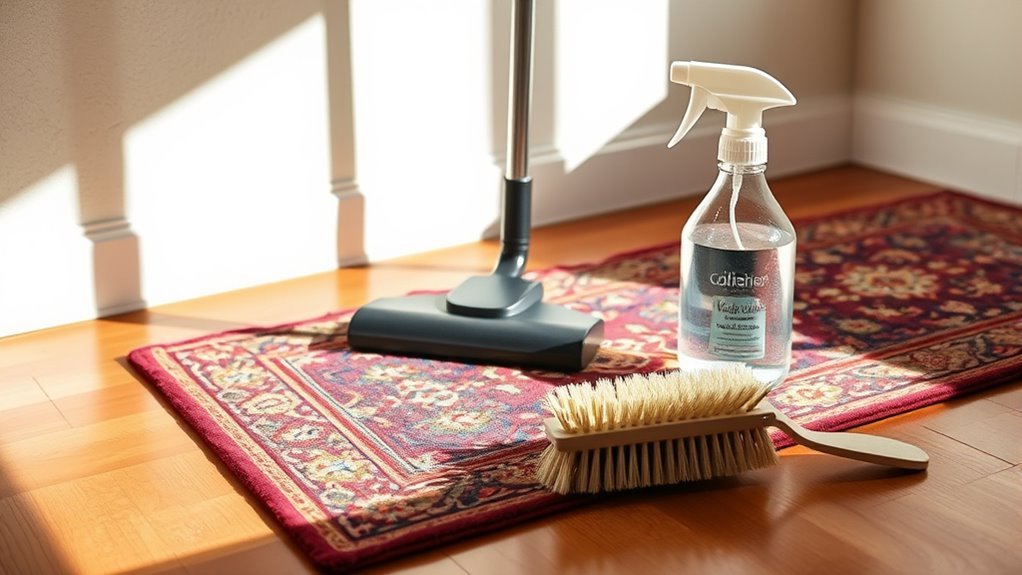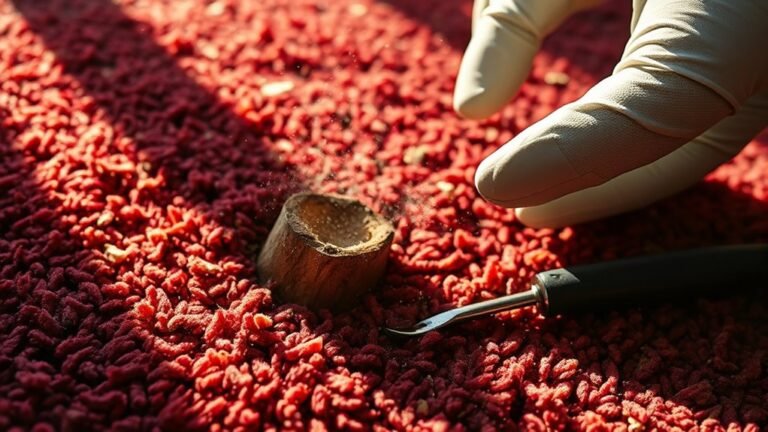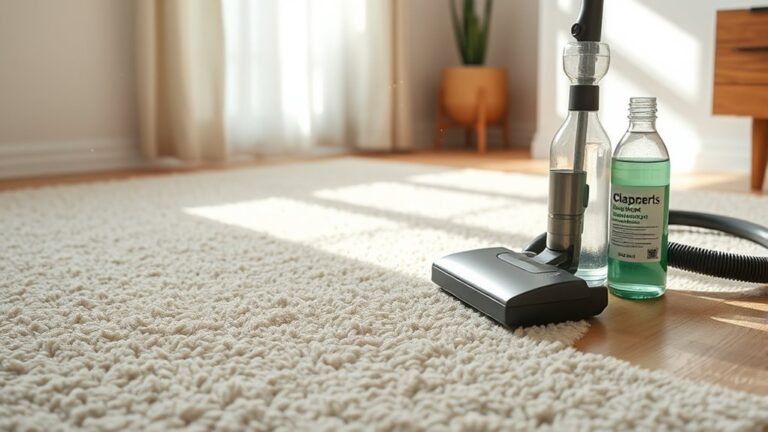Cleaning Techniques for Rug Owners
To clean your rug properly, first identify its material—wool, synthetic, or delicate fibers—since each requires specific care. Vacuum regularly using settings suited to your rug’s texture; use suction-only mode for fragile fibers. Act fast on spills by blotting gently and testing cleaning solutions on a hidden spot. Allow your rug to dry thoroughly in a well-ventilated area to prevent mold. For stubborn stains or deep dirt, professional cleaning may be necessary. Explore how to maintain and protect your rug’s beauty over time.
Understanding Different Types of Rugs
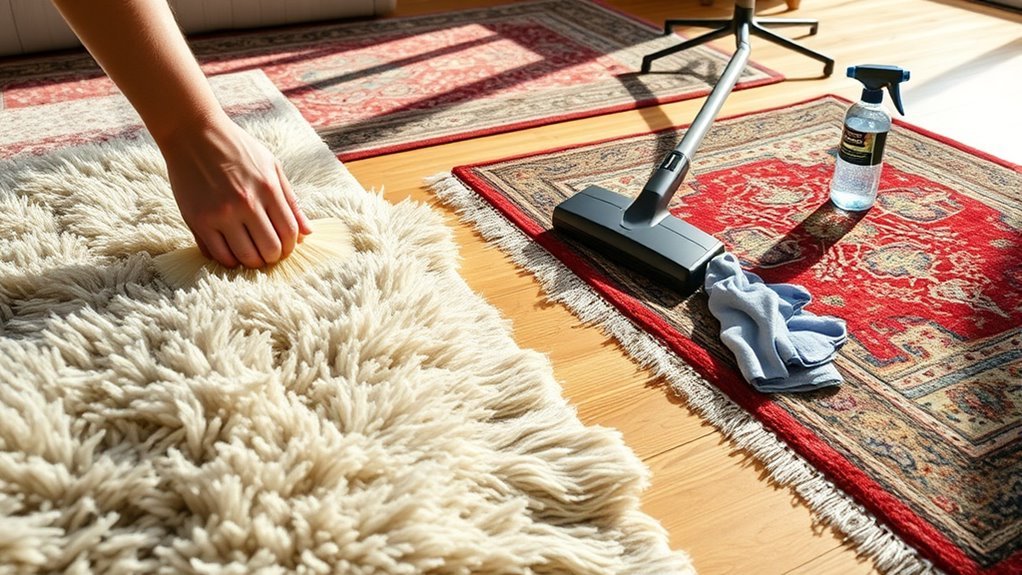
Before you begin cleaning your rug, it’s important to understand the type of rug you have, as different materials and weaves require specific care methods. Rug materials range from natural fibers like wool, cotton, and silk to synthetic ones such as nylon, polyester, and polypropylene. Each material demands tailored cleaning methods to maintain its integrity and appearance. For example, wool rugs benefit from gentle vacuuming and spot cleaning with mild detergents, while synthetic rugs often tolerate more aggressive cleaning techniques. Knowing the weave is equally essential; hand-knotted rugs need delicate handling, whereas machine-made rugs can endure standard cleaning processes. By identifying your rug’s material and construction, you’ll choose the most effective cleaning methods, preserving its quality and extending its lifespan without unnecessary damage or effort.
Daily Maintenance Tips for Rugs
Knowing your rug’s material and construction sets the foundation for effective daily care. To maintain your rug’s appearance and longevity, establish a consistent cleaning schedule tailored to its specific needs. Regularly shake out or gently beat smaller rugs outdoors to remove loose dirt and debris. Spot clean spills immediately using appropriate solutions to prevent stains from setting. Rotate your rug periodically to guarantee even wear and fading, especially if exposed to direct sunlight. Avoid placing heavy furniture on delicate fibers to prevent permanent indentations. Incorporate these daily maintenance habits to minimize deep cleaning frequency, preserving your rug’s texture and color. By following a disciplined rug care routine, you free yourself from costly repairs and extend your rug’s life with minimal effort.
Vacuuming Techniques for Various Rug Materials
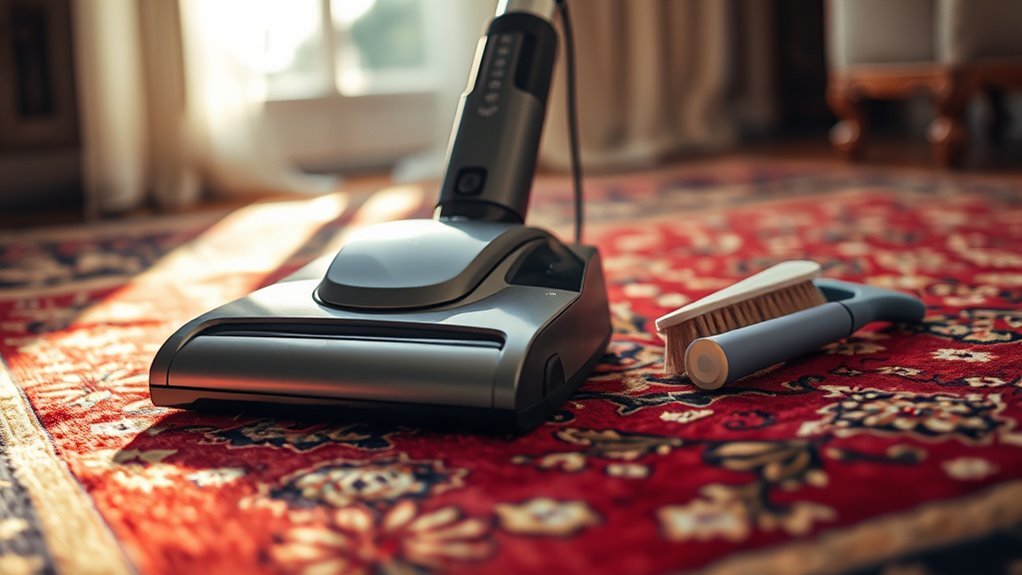
While vacuuming is essential for maintaining your rug’s cleanliness, using the right technique for each material is important to avoid damage. For delicate rugs like silk or antique wool, lower vacuum settings prevent fibers from loosening or fraying. Use a suction-only mode instead of rotating brushes, which can be too aggressive. Synthetic rugs tolerate stronger vacuum settings and rotating brushes, making it easier to remove embedded dirt. For shag rugs, adjust vacuum height to the highest setting and avoid beater bars that can pull strands. Always vacuum in the direction of the pile to preserve texture and appearance. Proper vacuum settings tailored to your rug type are significant for effective rug care, ensuring longevity and maintaining the freedom to enjoy your space without worry.
Spot Cleaning Methods for Common Stains
Vacuuming removes surface dirt, but stains can still appear unexpectedly, requiring prompt attention to prevent permanent damage. When you spot a stain, act quickly using the right cleaning solutions for effective stain removal. Follow these steps:
- Blot the stain gently with a clean cloth to absorb excess liquid—never rub, as it spreads the stain.
- Test your chosen cleaning solution on a hidden rug area to verify colorfastness.
- Apply the cleaning solution sparingly, targeting the stained area only.
- Rinse the spot with cold water and blot dry to remove residue and prevent re-soiling.
Deep Cleaning Rugs at Home
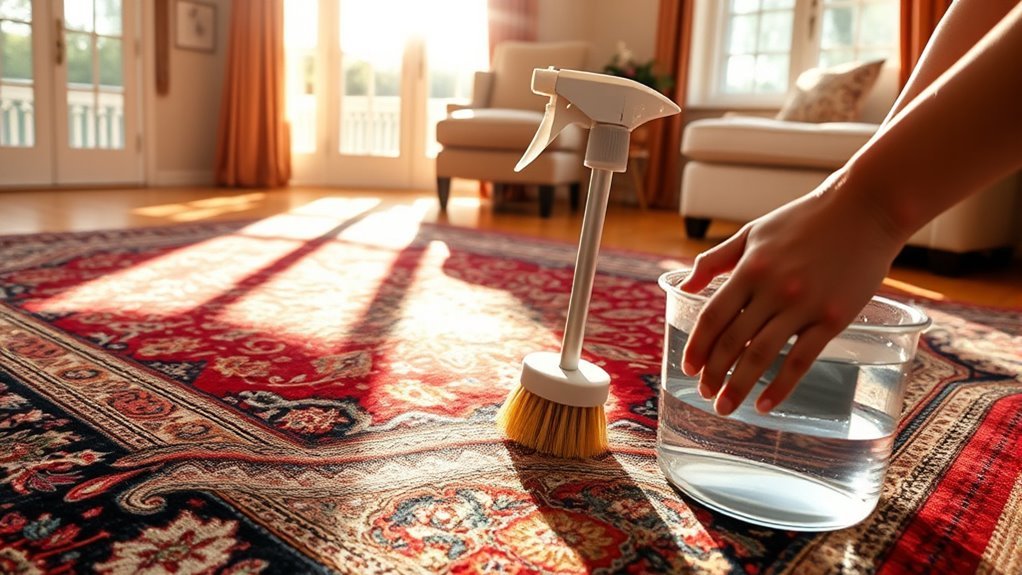
Although regular spot cleaning keeps your rug looking fresh, deep cleaning is crucial to remove embedded dirt, allergens, and odors that vacuuming alone can’t reach. To deep clean rugs at home, you can use steam cleaning or rug shampooing. Steam cleaning uses hot water vapor to penetrate fibers, loosening grime and killing bacteria without harsh chemicals. It’s effective for synthetic and durable natural fiber rugs. Rug shampooing involves applying a specialized detergent, scrubbing gently, then rinsing thoroughly to avoid residue buildup. Always test any cleaning method on a small, hidden area first to verify colorfastness. After cleaning, dry the rug completely to prevent mold growth. By mastering these techniques, you maintain your rug’s integrity and enjoy a healthier living space with minimal reliance on professional services.
Using Natural Cleaning Solutions Safely
Because natural cleaning solutions are gentler on both your rug fibers and indoor air quality, they’re an excellent choice for regular maintenance and spot treatments. When using natural ingredients, you can maintain your rug’s integrity while supporting eco friendly options. To use these solutions safely, follow these guidelines:
- Test a small, hidden area first to check for colorfastness and fiber reaction.
- Use diluted mixtures—concentrated natural acids like vinegar can damage fibers.
- Avoid over-saturating your rug; excess moisture promotes mold and mildew growth.
- Ventilate the room well to minimize any lingering odors and guarantee quick drying.
When to Use Professional Rug Cleaning Services
You should consider professional rug cleaning when stains persist despite your efforts or when your rug shows signs of wear and odor buildup. Experts use specialized equipment and techniques that protect delicate fibers and restore appearance effectively. Relying on their services guarantees a deeper clean and prolongs your rug’s lifespan.
Signs You Need Help
How do you know when it’s time to call in professional rug cleaning services? Paying attention to certain signs can prevent further rug damage and extend your rug’s life. While regular cleaning frequency is essential, some issues demand expert care.
- Persistent stains that resist your cleaning efforts.
- Noticeable fading or discoloration, indicating fiber damage.
- A musty or unpleasant odor that lingers despite airing out.
- Excessive dirt buildup embedded deep in fibers, beyond surface cleaning.
When you spot these signs, don’t hesitate. Professional cleaning safeguards your rug’s integrity, freeing you from the constraints of ineffective DIY attempts. Recognizing these signals empowers you to maintain your rug’s appearance and durability efficiently.
Benefits of Expert Cleaning
Although routine cleaning helps maintain your rug’s appearance, expert cleaning offers deeper benefits that DIY methods can’t match. When you choose professional services, you tap into expert techniques designed to remove embedded dirt, allergens, and stains effectively. This not only extends your rug’s life but also preserves its color and texture. Knowing when to use these services guarantees you enjoy long-term cleaning benefits without risking damage.
| Benefit | Description | When to Use |
|---|---|---|
| Deep Dirt Removal | Eliminates hidden dirt and dust | Annually or with heavy traffic |
| Stain Treatment | Targets tough, set-in stains | After spills or noticeable marks |
| Fabric Preservation | Maintains rug fibers and colors | Every 1-2 years or as needed |
| Allergen Reduction | Removes allergens and improves air | Seasonal or allergy season |
Rely on experts to keep your rug fresh and durable.
Drying and Airing Out Your Rug Properly
After cleaning, you need to dry your rug in ideal conditions with good airflow and ventilation to prevent moisture buildup. Make sure to hang or lay the rug flat in a well-ventilated area to speed up drying. Proper drying is essential to avoid mold growth and preserve your rug’s integrity.
Optimal Drying Conditions
When you’ve finished cleaning your rug, guaranteeing it dries under ideal conditions is crucial to prevent mold, mildew, and fiber damage. Proper humidity control and effective drying techniques play a key role in preserving your rug’s integrity. Here’s what you should do:
- Choose a low-humidity environment to speed up drying and inhibit mold growth.
- Elevate the rug off the ground to allow moisture to escape from both sides.
- Avoid direct sunlight if your rug’s colors are sensitive, as it can cause fading.
- Rotate the rug periodically during drying to guarantee even moisture loss.
Airflow and Ventilation
Proper airflow and ventilation are essential to drying your rug efficiently and preventing lingering moisture that can damage fibers or encourage mold growth. To guarantee your rug dries thoroughly, pay close attention to airflow patterns in the room. Position your rug where natural breezes circulate freely or use fans to create consistent air movement. If you have ventilation systems installed, utilize them to enhance air exchange, reducing drying time considerably. Avoid placing rugs in stagnant areas where air is trapped, as dampness will persist. By controlling ventilation and airflow patterns, you preserve your rug’s integrity while speeding up the drying process. This approach gives you the freedom to maintain your rug’s quality without relying on harsh chemicals or extended drying periods.
Preventing Mold Growth
Ensuring your rug dries completely through adequate airflow and ventilation directly reduces the risk of mold growth. Proper drying is essential for mold prevention and maintaining ideal humidity control in your living space. To dry and air out your rug properly, follow these steps:
- Hang your rug outdoors in a shaded, breezy area to avoid direct sunlight damage while enabling airflow.
- Use fans indoors to circulate air around the rug if outdoor drying isn’t feasible.
- Avoid placing rugs on damp surfaces or rolled up when still wet, as trapped moisture invites mold.
- Monitor indoor humidity levels with a hygrometer and maintain them below 60% to prevent mold spores from thriving.
Preventative Measures to Keep Rugs Clean Longer
Although regular cleaning is essential, taking preventative measures can greatly extend the life and appearance of your rugs. Start by investing in quality rug pads; they provide cushion, reduce wear, and prevent slipping. Pay attention to furniture placement—avoiding sharp pressure points will minimize permanent indentations. Regular rotation guarantees even wear and fading, especially in sunlit areas. For stain prevention, act quickly and use appropriate protectants designed for your rug’s material. Don’t hesitate to take rugs outdoors for routine cleaning; dust and debris are easier to remove outside, preventing buildup inside your home. Consistent rug protection maintains your rug’s vibrancy and structural integrity, giving you more freedom to enjoy its beauty without constant worry about damage or dirt accumulation.
Handling Delicate and Antique Rugs With Care
Extending the life of your rugs often means giving special attention to those that are delicate or antique. Handling these pieces with care preserves their beauty and value. Here are essential steps you should follow:
- Avoid harsh chemicals; use gentle cleaners designed for delicate fibers.
- Implement rug restoration techniques only when necessary, ideally by professionals.
- Rotate your rugs regularly to prevent uneven wear and sun damage.
- Follow antique care tips such as minimal vacuuming with a brushless attachment and immediate spot treatment to prevent stains.
Frequently Asked Questions
How Often Should I Rotate My Rug to Prevent Uneven Wear?
You should rotate your rug every 3 to 6 months to guarantee even wear patterns and extend its life. Regular rug maintenance like this prevents certain areas from becoming overly worn due to foot traffic or sunlight exposure. By staying consistent with rotation, you keep your rug looking fresh and balanced, giving you freedom from uneven damage and costly repairs. Make it part of your routine for ideal care and longevity.
Can Rugs Help Improve Indoor Air Quality?
Think of rugs as silent guardians working behind the scenes; they help improve indoor air quality by acting as natural air filtration systems. Your rug traps dust retention within its fibers, preventing particles from circulating freely in the air you breathe. However, to keep this benefit, you’ll need to clean your rug regularly; otherwise, trapped dust can become a source of allergens. So, rugs can help, but only if you care for them properly.
What Are the Best Rug Styles for High-Traffic Areas?
For high-traffic areas, you’ll want rugs made from durable materials like wool, nylon, or polypropylene since they resist wear and stains. Opt for pattern choices that camouflage dirt and stains—busy or geometric designs work best. These patterns let you maintain a clean look without constant upkeep. Choosing the right style guarantees your space stays vibrant and functional, giving you freedom from frequent replacements or intense cleaning sessions.
How Do Humidity Levels Affect My Rug’s Condition?
Humidity’s havoc harms your home’s hues and fibers. Without humidity control, moisture molds your rug’s materials, causing curling, color changes, and weakening weave. To guarantee rug preservation, monitor moisture levels and use dehumidifiers or air conditioners when needed. Keeping humidity balanced prevents damage and lets your rug maintain its look and longevity. You’ll enjoy freedom from worry when you manage the moisture, safeguarding your investment with smart, simple steps.
Are There Specific Cleaning Tools for Shag Rugs?
When tackling shag rug cleaning, you’ll want specialized vacuums designed to handle long fibers without damaging them. Standard vacuums can pull or tear the threads, so look for models with adjustable suction or no beater bars. Handheld tools or attachments with gentle bristles also work well. These tools let you maintain your shag rug’s plush texture while freeing you from worrying about wear or fiber loss during cleaning.
